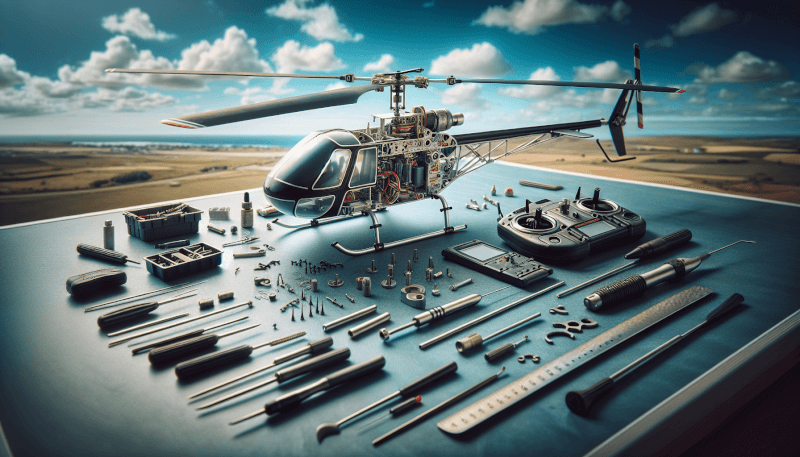So, you’ve just gotten your hands on a brand-new RC heli and you can’t wait to take it for a spin. But before you take off into the skies, it’s crucial to make sure your heli is in tip-top shape and ready to fly. In this article, we will cover the essential pre-flight checks that you should always perform before each flight. From inspecting the battery to checking the rotor blades, following these simple steps will not only ensure a safe and enjoyable flight, but also prolong the lifespan of your precious RC heli. So, let’s get started and make sure your heli is ready to soar like a pro!
Battery
Before taking off with your RC heli, it’s important to perform a series of pre-flight checks to ensure a safe and successful flight. One of the first areas to inspect is the battery. The battery is the heart of your RC heli, providing the power needed to lift off and stay in the air. To check the battery voltage, use a multimeter to measure the voltage level. Ensure that the voltage is within the recommended range for your specific RC heli model. If the voltage is too low, it may indicate that the battery needs to be charged or replaced.
In addition to checking the voltage, it’s essential to inspect the battery for any signs of damage or swelling. Look for any visible cracks, dents, or bulges on the battery casing. Swelling or bulging can be a sign of internal damage and should be addressed before flying. If you notice any damage or swelling, it’s best to replace the battery to avoid any potential safety hazards.
Lastly, make sure that the battery is securely connected to the RC heli. Ensure that the connectors are tightly plugged in and that there is no loose wiring. A loose or improper connection can lead to power loss or intermittent electrical issues during flight. Take the time to double-check the battery connection to ensure a secure and reliable power source for your RC heli.
Transmitter
The transmitter is a crucial component of your RC heli, as it allows you to control and navigate the aircraft. Before taking off, it’s necessary to inspect the transmitter and perform a few checks. Start by checking the transmitter battery. Ensure that it is fully charged or has sufficient power to last through your flight session. A low battery can result in loss of control or signal interference, leading to a potentially dangerous situation. It’s always a good idea to carry spare batteries for your transmitter, just in case.
Next, make sure that the transmitter is switched on. It may sound obvious, but sometimes it’s easy to forget to power on the transmitter before taking off. Double-check that the power switch is in the correct position and that the transmitter is functioning properly.
Inspect the transmitter for any physical damage, such as cracked casing or loose switches. Physical damage can compromise the functionality of the transmitter and make it difficult to control your RC heli. If you notice any damage, it’s best to address it before flying to avoid any potential mishaps.
Lastly, check the transmitter settings to ensure that they are configured correctly. Verify that the control sticks and switches are in the neutral position and that any trim settings are properly adjusted. This step will help ensure that your RC heli responds accurately to your inputs and flies smoothly.

Receiver
The receiver is responsible for receiving and interpreting the signals from the transmitter, allowing your RC heli to respond to your commands. It’s important to check the receiver before each flight to ensure its proper functioning.
Start by checking the receiver battery. Verify that it has sufficient power or is fully charged. A low battery can result in signal loss or intermittent response from your RC heli. Always make sure to have spare batteries for your receiver, just in case.
Additionally, ensure that the receiver is securely connected to your RC heli. Check that all the wiring and connectors are properly plugged in and that there are no loose connections. A loose connection can cause signal interference or loss of control during flight, jeopardizing the safety of your RC heli.
Inspect the receiver for any physical damage, such as cracked casing or exposed wires. Physical damage can affect the receiver’s functionality and compromise the control of your RC heli. If you notice any damage, it’s best to address it before flying to avoid any potential issues.
Lastly, check the receiver settings to ensure they are properly configured. Ensure that the channels and frequencies match the settings on your transmitter. This step will help ensure a stable and reliable connection between the transmitter and receiver, allowing for accurate control of your RC heli.
Propellers
The propellers are responsible for generating the lift and thrust needed to keep your RC heli in the air. Before each flight, it’s crucial to inspect the propellers and perform a few checks.
Start by inspecting the propellers for any signs of damage or wear. Look for any cracks, chips, or deformation on the propeller blades. damaged or worn propellers can lead to imbalanced flight and reduced performance. If you notice any damage, it’s best to replace the propellers to ensure a safe and stable flight.
Ensure that the propellers are securely attached to the motor shafts. Check that the propeller nuts are tightened properly and that there is no play or wobbling in the propellers. Loose propellers can detach during flight, posing a risk to the RC heli and surrounding objects. Take the time to tighten the propellers securely, ensuring their stability.
To achieve smooth and balanced flight, it’s important to check the propeller balancing. Use a propeller balancing tool or even a simple balancing rod to check and correct any imbalances. Balanced propellers will reduce vibration and improve the overall performance and lifespan of your RC heli.

Frame
The frame of your RC heli provides support and structural integrity, holding all the components together. It’s essential to inspect the frame before each flight to ensure its integrity and prevent any potential issues.
Inspect the frame for any cracks, dents, or damage. Pay close attention to areas where stress is concentrated, such as motor mounts or landing gear mounting points. A cracked or damaged frame can compromise the structural integrity of your RC heli, leading to unexpected failures during flight. If you notice any damage, it’s crucial to address it and consider replacing the frame if necessary.
Ensure that all screws and connections on the frame are tightened securely. Loose screws or connectors can result in vibrations or even component detachment during flight. Take the time to check each screw and connection point, ensuring that they are tightened properly. However, be cautious not to overtighten, as this can lead to stripped threads or damage the frame.
Check the frame alignment to ensure that all components are properly aligned. Misaligned components can cause imbalanced flight or affect the overall stability and control of your RC heli. Take the time to check that all components, such as the motors, receivers, and flight controller, are aligned correctly within the frame.
Motors and ESC
The motors and Electronic Speed Controllers (ESCs) are responsible for powering and controlling the rotation of the propellers, providing the necessary thrust for flight. Before each flight, it’s important to inspect the motors and ESCs and perform a few checks.
Inspect the motors and ESCs for any signs of damage, such as dents, scratches, or loose wiring. Physical damage can affect the performance and reliability of the motors and ESCs, leading to potential issues during flight. If you notice any damage, it’s best to address it before flying to ensure safe operation.
Ensure that the motors are properly connected to the ESCs. Check that all the wiring and connectors are securely plugged in and that there are no loose connections. A loose connection can result in power loss or intermittent operation of the motors, jeopardizing the stability and performance of your RC heli. Take the time to double-check the motor connections, ensuring their proper functioning.
Check the ESC settings to ensure they are properly configured. Ensure that the throttle range is calibrated correctly and that any special features or settings are properly set. This step will help ensure that the motors and ESCs respond accurately to your inputs and operate smoothly throughout the flight.

Servos
The servos are responsible for controlling the movement of various parts of your RC heli, such as the swashplate or tail rotor. Before each flight, it’s important to inspect the servos and perform a few checks.
Inspect the servos for any signs of damage, such as cracked casings or loose wiring. Physical damage can affect the performance and reliability of the servos, leading to potential control issues during flight. If you notice any damage, it’s best to address it before flying to ensure safe and accurate servo operation.
Ensure that the servos are securely attached to the corresponding control surfaces. Check that all servo arms and linkages are properly connected and that there is no excessive play or looseness. Loose servos can result in unpredictable and erratic movement, making it difficult to control your RC heli. Take the time to tighten the servos securely, ensuring their stability.
Check the servo operation and alignment. Verify that the servos respond accurately to your inputs and that they move smoothly without any binding or jerking. Additionally, ensure that the servo arms and linkages are properly aligned, providing even and consistent movement. Performing these checks will help ensure precise control and stability during your RC heli flight.
Gyro and Flight Controller
The gyro and flight controller are responsible for stabilizing your RC heli and providing stability and control during flight. Before taking off, it’s important to inspect the gyro and flight controller and perform a few checks.
Inspect the gyro and flight controller for any signs of damage, such as cracked casings or loose wiring. Physical damage can affect the performance and reliability of the gyro and flight controller, compromising the stability and control of your RC heli. If you notice any damage, it’s best to address it before flying to ensure safe and accurate operation.
Ensure that the gyro and flight controller are properly calibrated and have the correct settings. Follow the manufacturer’s instructions or the guidelines specific to your RC heli model to ensure that the calibration and settings are accurate. Proper calibration and settings will enhance the stability and responsiveness of your RC heli, providing a smoother and more enjoyable flight experience.
Check the flight modes and stabilization settings on your RC heli. Ensure that they are properly configured to suit your preferences and flying style. Take the time to familiarize yourself with the different flight modes and stabilization options provided by your gyro and flight controller, maximizing the capabilities of your RC heli during flight.

Antenna
The antenna plays a vital role in maintaining a strong and reliable signal between your RC heli and the transmitter. Before each flight, it’s important to inspect the antenna and perform a few checks.
Inspect the antenna for any signs of damage or wear. Look for any cuts, kinks, or frayed wires on the antenna. Damaged or worn antennas can weaken the signal strength and range of your RC heli, resulting in a loss of control or signal interference during flight. If you notice any damage, it’s best to replace the antenna to ensure a strong and stable signal.
Ensure that the antenna is securely attached to your RC heli. Check that the antenna mount or connector is properly fastened and that there are no loose connections. A loose antenna can result in signal loss or intermittent communication, affecting the control and performance of your RC heli. Take the time to double-check the antenna connection, ensuring its reliability.
Check the antenna range and signal strength before each flight. Perform a range test to determine the maximum distance at which you can maintain a strong and reliable signal between your RC heli and the transmitter. This step will help you identify any signal issues or limitations, allowing you to adjust your flight plans accordingly.
Safety Precautions
Flying an RC heli can be a thrilling and enjoyable experience, but it’s important to prioritize safety. Before taking off, ensure that you are in a safe flying area. Choose an open space away from congested areas, people, and any potential obstacles. This will minimize the risk of accidents and property damage.
Check for any obstructions or hazards in the flying area, such as trees, power lines, or other structures. Clear any potential obstacles that may interfere with the flight path of your RC heli. It’s essential to have a clear and unobstructed space to ensure a safe and unrestricted flight.
Always follow local regulations and laws pertaining to RC heli flying. Familiarize yourself with any restrictions, permits, or guidelines set by your local authorities. Adhering to these regulations will help ensure a safe and legal flight, avoiding any potential legal issues or penalties.
Wear appropriate safety gear, such as eye protection and comfortable clothing. Flying an RC heli can involve fast-moving parts and potential hazards, so it’s important to protect yourself from any possible injuries. Safety gear will provide an added layer of protection and peace of mind during your RC heli flights.
By performing these essential pre-flight checks and following the recommended safety precautions, you can ensure a safe and enjoyable flying experience with your RC heli. Regular inspections and maintenance will contribute to the longevity and performance of your RC heli, allowing for countless hours of thrilling flights. Remember, safety should always be your top priority when operating an RC heli, so take the time to perform these checks before every flight. Happy flying!



